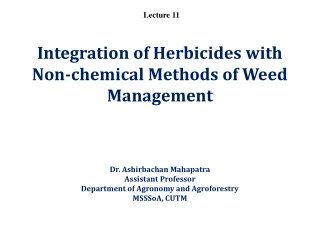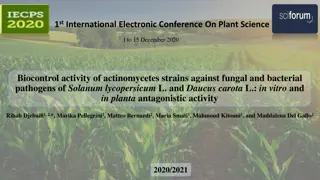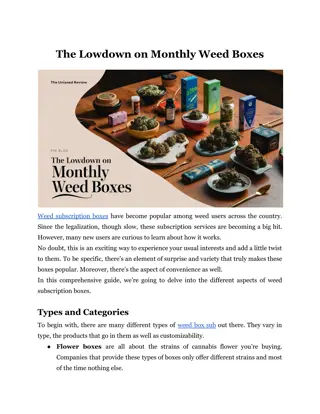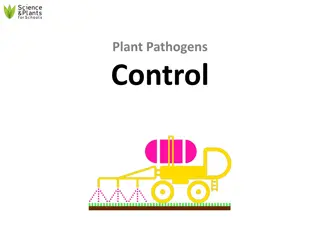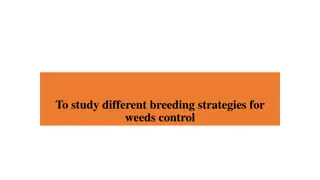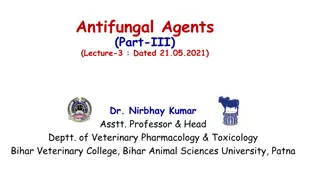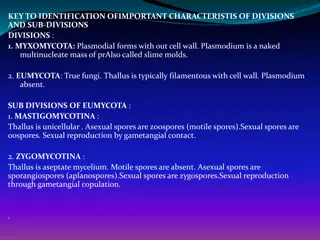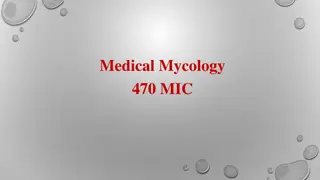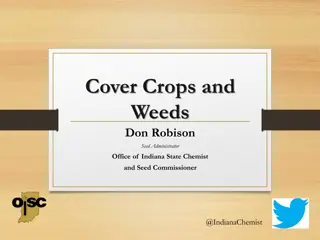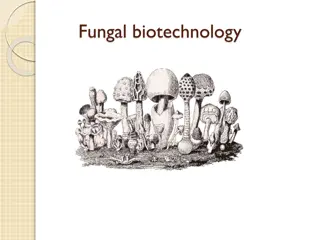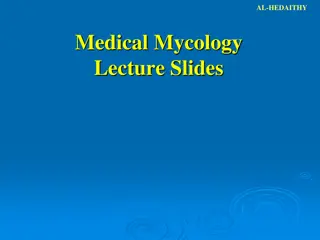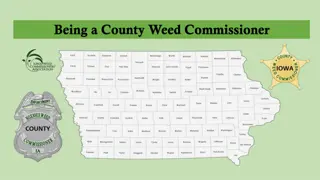Understanding Mycoherbicides: Effective Weed Control Using Fungal Pathogens
Mycoherbicides are biologically based agents derived from fungi to control weeds. They are cost-effective, stable, and environmentally friendly. History shows successful experiments in using mycoherbicides to combat invasive plant species. These agents work by releasing phytotoxins that kill target plants, offering a sustainable alternative to traditional herbicides.
Download Presentation

Please find below an Image/Link to download the presentation.
The content on the website is provided AS IS for your information and personal use only. It may not be sold, licensed, or shared on other websites without obtaining consent from the author. Download presentation by click this link. If you encounter any issues during the download, it is possible that the publisher has removed the file from their server.
E N D
Presentation Transcript
MYCOHERBICIDES MYCOHERBICIDES
MYCO-HERBICIDE From Greek, Mukes Any weed killing pesticide - Can be synthetic OR - Derived from some biological Meaning Fungus source
BIOHERBICIDES Biologically based control agent for weed Consists of any naturally occurring PATHOGEN Is indigenous in a population of target plant Use of fungal pathogens as controlling agent for weeds .MYCOHERBICIDES MYCOHERBICIDES
Fungi which can be used as Mycoherbicide usually are: Obligate parasite Native to the area Host specific
Mycoherbicide should be Low in cost Culturable in artificial media. Capable of abundant spore production. Stable in storage Genetically stable Effective under field condition Tolerant to variation in Temperature Compatible with other chemical cultural practices.
HISTORY OF MYCOHERBICIDES First attempt was done in Hawaii in 1940 and was unsuccessful Used Fusarium oxysporum to control white form of Pricky pear (Opuntia megacantha)
CONTD Successful experiment was done in US in 1960s Used Acremonium diospyri to control weedy persimmon (Diospyros virginiana) DeVine, DeVine, o first mycoherbicide to be registered in 1981 o In US by U.S environmental protection agency (EPA) o Composed of Phytophthora palmivora strain MWV
Was developed by researchers in 1960s & 1970s to control Milkweed vine/ stranglervine (Morrenia odorata) citrus groves Collego, aeschynomene, Ecogen, University of Arkansas. Colletotrichum gloeosporioides f.sp. Anthracnose on northern jointvetch, a leguminous weed in rice and soybeans Wet able powder applied with conventional herbicide sprayers English pea and broadbean are susceptible
HOW MYCOHERBICIDES WORK? 1. Spore germination 2. Phytotoxins release PHYTOTOXINS RELEASE PHYTOTOXINS RELEASE (Misra, 2005) Mycoherbicides release phytopathogens when sprayed on target plant Phytopathgens release phytotoxins Phytotoxins kill the target plant up to 5 weeks
Spore production/physical infection Spore production/physical infection (Batron, 2004) Application of mycoherbicide to target plant Production of stable and temperature tolerant spores GERM TUBE to infect upper layers of leaf Germination of spores Appressoria is created Infection spread outwards
PURPOSE OF MYCOHERBICIDES
Growth of weeds in a crop compete with the plants in terms of nutrients, water and survival May result in the loss of grower s expected yield The lost yield results in economic losses A problem in the agriculture industry
Bioherbicides can constitute an alternative to mechanical methods & chemical herbicides Mycoherbicide is created with the fungi as its active ingredient The MYCOHERBICIDE inhibit the weed growth without harming the crop or the living organisms surrounding it
SCOPE OF MYCOHERBICIDES Host specific & will reside on the soil or weed host Don t disturb other plants or living organisms present there Long lasting Survive in soil for extending period of time Cause disease in succeeding crops of target plant sp Help to mitigate the adverse effects of chemical herbicides Such as, ground and water contamination Non-target effects Development of herbicide resistance
CONTD. Cheaper alternative to expensive mechanical controls Used to control illicit drug crops Fusarium oxysporum & Crivellia papveracea controls coca, cannabis, opium etc. Coca Cannabis Opium
CHALLENGES Anti-herb capacity is generally less than that of a chemical herbicide Success rate is dependent up on environmental conditions & are host specific For foliar biocontrol agents some factors influencing plant infection are: Temperature Free moisture/dew period Protection against UV irradiation
CONTD. Necessary to include: Good market potential Ease of production & application Adequate product stability Sufficient shelf life during transportation & storage
CASE STUDY Mycoherbicidal potential of Alternaria alternata ITCC4896 for the control of Parthenium hysterophorus
Parthenium hysterophorus Ragweed Parthenium; Carrot weed; Congress grass; White tops Accidently introduced in India in 1950s Among worst top 10 weeds of the world (Holm et. Al. 1977) Hazard to livestock & humans Responsible for allergic rhinitis, nasobronchial allergies etc. in humans eventually leading to deaths Become resistant to chemical pesticides like Trifluralin, Atrazine 2,4-D etc.
A. alternata mycoherbicidal potential was observed o in vitro Detached leaf bioassay o In vivo whole plant bioassay
INOCULUM PREPARATION 4 spore conc. Were tested A. alternata was grown on PDA (26 2 C) for 7 days Conidia was harvested by flooding the petri dishes with sterile distilled water The conidial suspension was filtered to remove mycelial bits Resulted suspension was centrifuged (8000 rpm for 10mins) Resulted pellet was resuspended using SDW & different conidial conc. Were prepared
DETACHED LEAF BIOASSAY Leaves were excised from shoots at preflowering stage 9 replicates comprising of 3 leaves each were tested Fungal inoculum was sprayed evenly 3 replicates (3 leaves each) served as control(received only SDW) All treatments were kept in a growth chamber (26 2 C; 75 15 %) relative humidity and 15 h illumination period) for one week Leaves were rated for disease severity every 12 h on a 5-point scale
RESUTS Concentration of 1x10^6 spores/mL was found to be most effective Caused 89.2 % of average leaf damage Therefore used for whole plant bioassay
WHOLE PLANT BIOASSAY 4-6 week old plants having 4-8 leaves were grown in pots in a growth chamber with illumination of 12 h daily for a week Sprayed with fungal inoculum of a spore conc. Of 1x10-6 spores/mL Experimental set had 10 replicates The control set received only SDW Covered with plastic bags and kept in controlled conditions Plants were observed daily for disease severity until all plants were dead The experiment was repeated thrice
RESULTS Onset of disease after 24 h of treatment Complete death after 7 days 50% damage of weed was recorded on 4th day 60% mortality was observed in detached leaf bioassay on 4th day

 undefined
undefined









 undefined
undefined
